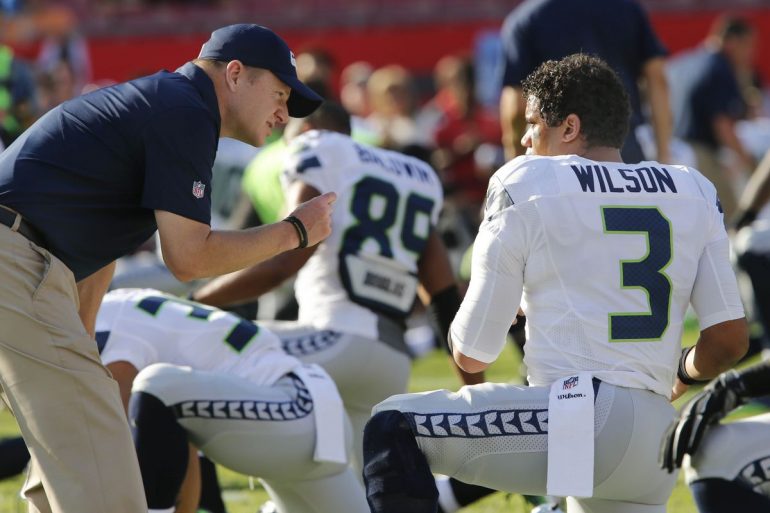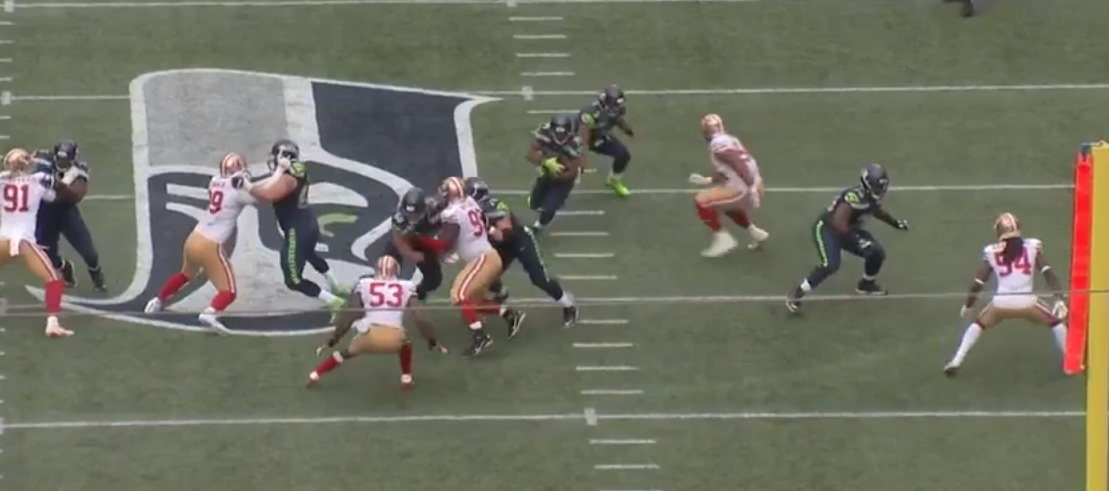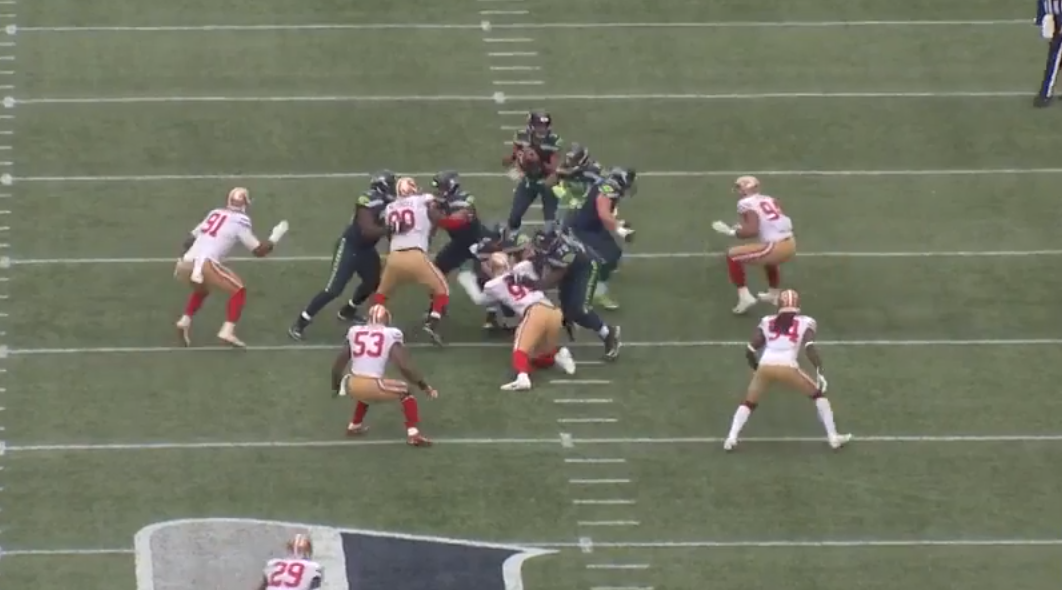After setting a low bar in week 1, the Seattle offensive line showed signs of improvement in week 2. There were still major issues to be sure, but the run game showed signs of life and Russ was able to enjoy a clean pocket from time to time. Part of this was because of improved play by the offensive line, part of this was probably because of the lower level of competition last week, and a big part of it was because of Seattle’s offensive game plan.
To get the run game going, Seattle used a heavy dose of read option. These plays were mixed in right away on the first drive. The very first play of the game, while not read option and not a particularly good play, put the Niners on alert that Russell would need to be defended both in the air and on the ground.
I really don’t like this play as it takes too long to develop and gives Russ only the option to run, but it’s clear why it was the first play in Seattle’s opening script. Second level defenders must respect Russell’s ability to pick up yards with his feet. Seattle would demonstrate this again later in the drive when faced with a 4th down.
Despite the opening play call, Ray Ray Armstrong completely ignores Russ on the keeper. Russ picks up 9 yards and an easy first down.
Catching the defense by surprise and picking up some easy yards with your quarterback is nice, but the effect of running read option is much greater than that. Two drives later, Seattle runs it again.
Ray Ray is prepared this time for the keeper and drifts to his right, taking himself out of the play. Solomon Thomas is released, completely unblocked, and should be in position to blow up the run for a loss. But instead of tackling Rawls in the backfield, he freezes to see if Russ still has the ball.
The WR screen action at the bottom of the play pulls away Reed, and Seattle goes from having 6 blockers vs 7 defenders in the box to 5 vs 4. Defenses inherently have a number advantage in the run game with the offensive effectively playing 10 on 11, as the QB does not participate. The goal read option is to negate that advantage by using the threat of a keeper to freeze a linebacker, Armstrong in this case. And on this play, it works to perfection.
Seattle would enjoy this advantage throughout the game. Here are two more examples, the first from Seattle’s touchdown drive and the second from the last drive of the game.
Tartt and Armstrong both bite down hard to keep Russell in check, giving Seattle’s line a 6 vs 5 advantage. Carson has a huge hole and rumbles for 14 yards.
This play doesn’t pick up many yards, but it does convert a first down. And again, you can see Armstrong has a huge gap in front of him but is held in the second level by the threat of a QB keeper.
Seattle wasn’t just content to use the read option in the run game. The Seahawks were able to use read option looks to help in pass protection as well. From the first drive of the game
Seattle does a couple things here. First, they run play action off of a read option look, leaving both ends unblocked. Prosise is asked to pick up one of the defensive ends as he comes across the formation. At the same time, Glow pulls across the formation in the other direction to pick up the unblocked “read” defender. Despite both ends being completely unblocked, the misdirection freezes both players and creates a clean pocket for Russ.
Here’s another example of Seattle creatively using read option looks to help the line in pass protection, also from the first drive.
Seattle again uses play action off of the read option, but this time Russ simulates a keep by rolling out to his left. To help protect against the defensive end quickly reading the play and getting a clean shot at Russ, Baldwin cracks back from the slot position. The downside to this is that Russ is now looking to make a throw on the run, and he does end up making a poor pass (and probably a poor read too). But throwing on the run is generally a strength for Wilson, and this is a great way to take advantage of his skill set and the read option.
Seattle also just found ways to move the pocket, frequently using play action.
Seattle runs play action off outside zone and the whole line washes away, leaving Russ with great protection. And again here, Russ rolling out off play action.
There are still many issues for this offense, and this offensive line especially, to work out. But against San Francisco, Bevell and crew put together a great game plan to help address those issues. If the Seahawks can replicate this success schematically while reducing the number of bad throws and drops, which seems reasonable to expect, Seattle’s offense should start to pick up steam.


